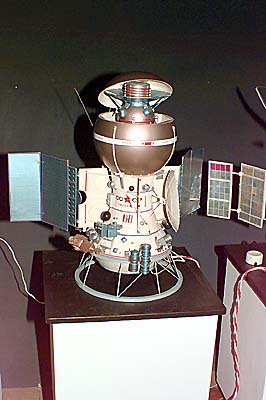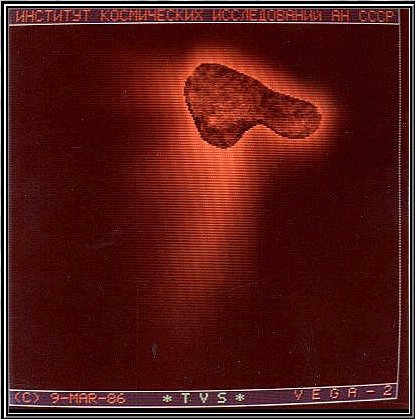

taken by "Vega-2"
 |
 |
|
| Space ship "Vega-2" | A photograph of the Halley comet core taken by "Vega-2" |
|
SPACECRAFT COMMON NAME - IK BULGARIA 1300 ALTERNATE NAME- INTERCOSMOS BULGARIA 1300, 12645 NSSDC ID - 81 -075A LAUNCH DATA - 08/07/81 LAUNCH SITE - LAUNCH VEHICLE - METEOR SPONSORING COUNTRY/AGENCY BULGARIA BAS Russia INTERCOSMOS INITIAL ORBIT PARAMETERS ORBIT TYPE - GEOCENTRIC EPOCH DATE- 08/08/81 ORBIT PERIOD - 101.9 MIN INCLINATION- 81.2 DEG PERIAPSIS - 825. KM ALT APOAPSIS- 906. KM ALT PERSONNEL PM - A.G. IOSIPHIAN INTERCOSMOS PM - K.B. SERAFIMOV CLSR-BAS PS - M.M. GOGOSHEV CLSR-BAS PS - I.S. KUTIEV CLSR-BAS PS - V.M. BALEBANOV IKI |
|
BRIEF DESCRIPTION The spacecraft contained a set of plasma, particles, fields, and optical experiments that were designed and constructed in Bulgaria. The spacecraft was three-axes stabilized with negative Z-axes pointing toward the center of the earth and X-axes pointing along the velocity vector. The outer skin of the spacecraft, including the solar panels, was coated with a conducting material in order to allow the proper measurement of electric fields and low energy plasma. Both active and passive thermal control were employed. The solar panels supplied 2 kilowatts and batteries were used during eclipse periods. There were two tape recorders, each with a capacity of 60 megabits. The transmitter radiated about 10 w in the 130 MHz band. |
